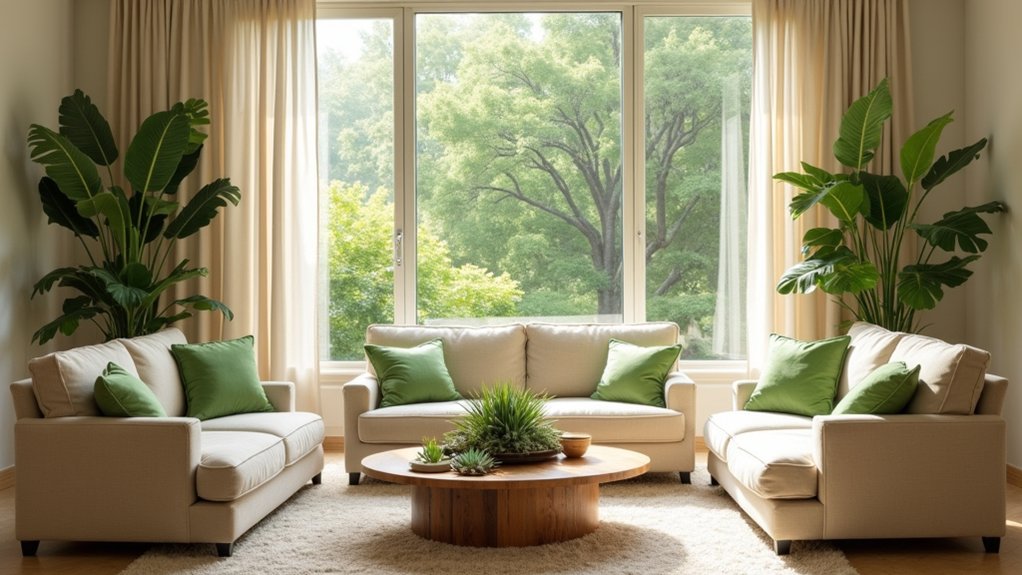
15 Beige Living Room Ideas With Green Accents for a Nature-Inspired Feel
A beige living room raised with green accents creates a tranquil, nature-inspired retreat through cohesive color harmony and organic elements. Creamy neutrals form a calming backdrop, while green tones appear in accent walls, textiles, and botanicals to strengthen biophilic design. Plush textures, subtle patterns, and woven materials add tactile richness, while modern and classic furniture mixes guarantee visual balance. Strategic lighting and open layouts optimize spatial flow and serenity. Discover versatile approaches that transform simple spaces into restorative environments.
Key Takeaways
- Incorporate sage green accent walls to create a tranquil, nature-inspired focal point in a beige living room.
- Layer plush textures like velvet cushions and linen throws in green and neutral tones for cozy, organic comfort.
- Add botanical decor with potted plants and green ceramics to reinforce a biophilic, nature-connected atmosphere.
- Use rattan furniture and woven baskets for earthy texture and visual warmth alongside green accents.
- Integrate statement green artwork and subtle patterned textiles to introduce visual interest and natural harmony.
Cream and Green Color Harmony
When utilized together, cream and green establish a visually balanced color harmony that is both tranquil and inviting.
In interior design, the cream and green color harmony leverages cream’s warmth as a foundational neutral, complemented by varying green tones introduced through accent elements such as cushions, botanical artwork, and indoor plants.
The juxtaposition of soft cream and vibrant green tones generates a peaceful, cohesive environment. Textural variation—incorporating woven rugs, tactile linens, and organic materials—amplifies visual interest and depth, preventing monotony within the palette.
Functionally, this color pairing fosters a restful atmosphere while echoing natural motifs, making it particularly effective for living rooms aimed at relaxation and biophilic connection.
Cream and green together evoke tranquility and nature, cultivating a restful living space perfect for relaxation and biophilic comfort.
Including Pothos or Monstera in your living room design not only enhances the aesthetic but also improves air quality and regulates humidity, further promoting a serene environment.
The synergy between cream and green tones guarantees continuity and a welcoming ambiance grounded in nature-inspired aesthetics.
Sage Green Accent Walls
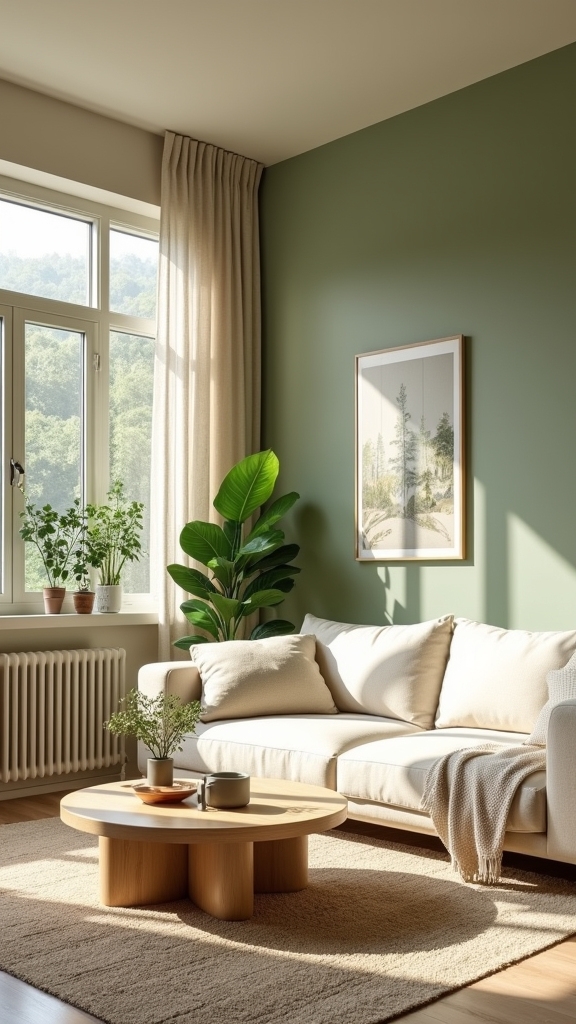
A sage green accent wall serves as a strategic focal point within a beige living room, introducing a muted botanical hue that enhances spatial tranquility. This specific shade of green creates a seamless visual connection between the neutral warmth of beige and the organic undertones of nature-inspired decor. The soft, subdued character of sage green accentuates natural light, lending the space an expansive and airy perception. Its chromatic versatility allows for effortless integration with a spectrum of interior design styles, from contemporary minimalism to rustic chic. Functionally, a sage green accent wall anchors the room’s palette, supporting harmonious pairings with wooden furnishings and live greenery. The resulting atmosphere fosters relaxation, underscoring the restorative qualities of a nature-centric living environment while maintaining cohesive sophistication. To enhance the aesthetic appeal, consider incorporating metallic lighting fixtures and warm brass finishes.
Plush Textures for Cozy Comfort
Plush textiles serve as essential components in elevating the tactile comfort of a beige living room with green accents. Utilizing plush textures such as velvet and chenille for sofas and chairs not only amplifies seating comfort but also introduces a refined visual softness. Layering chunky knit throws and soft linen pillows provides both thermal warmth and depth, ensuring the environment feels welcoming. Textured rugs, including wool or jute, effectively ground the space while visually harmonizing with the plush textures of upholstered furniture. Accessories like faux fur or knitted poufs deliver additional softness, enhancing the room’s inviting character. Contrasting these plush elements with sleek surfaces—such as polished wood or metal accents—achieves a sophisticated equilibrium, balancing tactile luxury with structural clarity in the overall design. Incorporating natural fabrics and sustainable options such as linen, cotton, and wool not only aligns with sustainable design trends but also complements the cozy feel of the living room.
Botanical Decor With Potted Plants
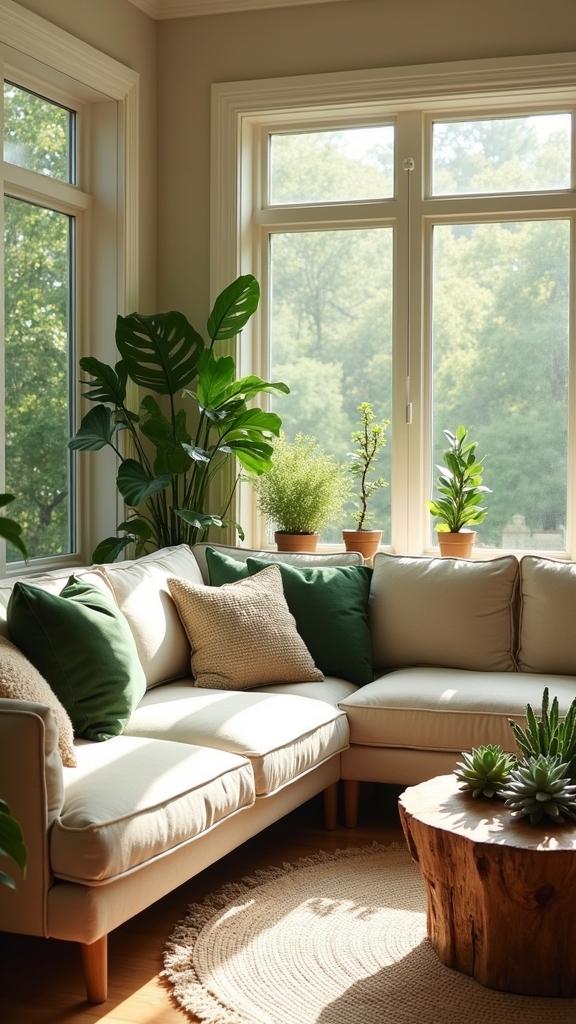
Selecting botanically robust species such as snake plants or pothos introduces both visual vibrancy and functional air purification to a beige living room.
Strategic placement—varying plant heights and integrating decorative pots in green or earthy hues—maximizes visual impact and cohesion with the room’s color palette.
Thoughtful arrangement guarantees greenery becomes an intentional design element, enhancing spatial depth and ambiance.
Incorporating low-maintenance plants like the String of Hearts ensures that your living room remains both stylish and easy to care for, while contributing to a serene atmosphere.
Choosing the Right Plants
How does one achieve a harmonious blend of botanical decor within a beige living room? The deliberate selection of low-maintenance species—such as snake plants and pothos—ensures sustained greenery with minimal care, making them perfect for integrating green shades into a neutral palette.
Incorporating a spectrum of plant forms, from the upright silhouette of the fiddle leaf fig to the cascading lines of philodendrons, introduces both verticality and dynamic texture. Placement near ideal natural light sources is critical, as most indoor flora require bright, indirect sunlight for robust health.
Additionally, decorative pots in complementary green or cream tones reinforce the nature-inspired theme, visually anchoring the botanicals within the existing color scheme. Strategic plant selection therefore establishes an enduring, tranquil environment.
Arranging Greenery for Impact
A thoughtful arrangement of potted plants in varying sizes and heights introduces visual rhythm and organic energy to a beige living room.
For impactful botanical decor, experts recommend placing substantial specimens such as fiddle leaf figs or rubber plants in corners or key sightlines, establishing focal points and enhancing the nature-inspired feel.
Smaller potted plants, when grouped on shelves or side tables, create a layered composition that adds depth and interest.
Utilizing both leafy greens and flowering varieties introduces textural contrast and vibrant green accents, reinforcing the connection to nature.
Selecting decorative pots in tones that harmonize with the beige living room palette maintains visual cohesion.
Ensuring proper placement according to each plant’s light requirements fosters healthy growth, optimizing both aesthetic impact and air-purifying function.
Layered Rugs in Neutral Tones
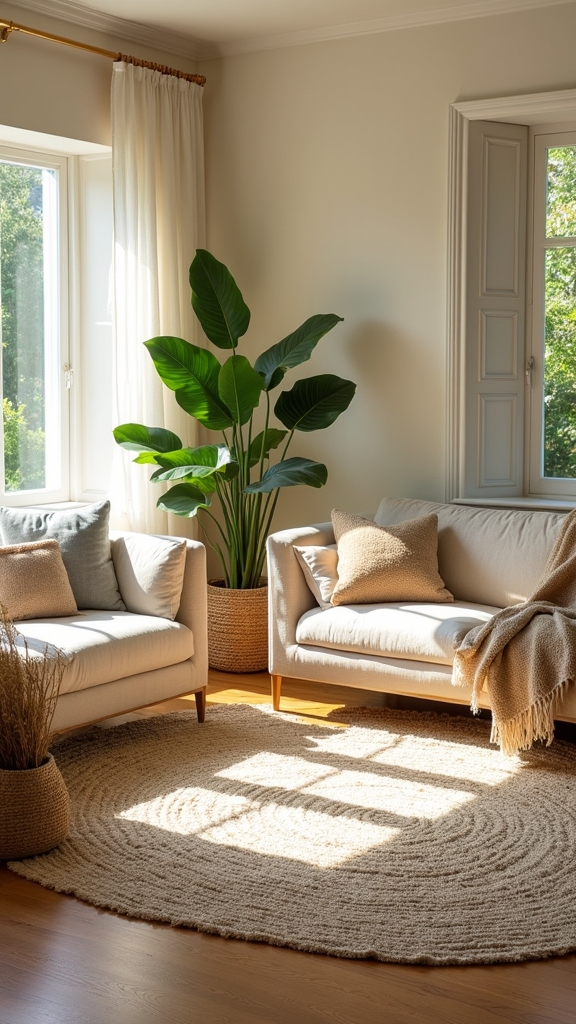
Layered rugs in neutral tones introduce both visual depth and tactile dimension to the beige living room, strategically mixing materials such as wool, jute, and sisal for nuanced effect. Plush textures paired with flat weaves not only enhance warmth but also support a cohesive, monochromatic palette. This approach maximizes comfort and spatial definition while providing an understated stage for green accent elements. Incorporating natural materials and houseplants complements the earthy tones and adds a refreshing touch to the overall decor.
Mixing Materials for Depth
Elevating a beige living room’s design, the strategic layering of rugs in neutral tones—such as beige and cream—introduces essential visual depth and a welcoming, nature-inspired ambiance.
The interplay between smooth and textured materials, for instance, a foundational flatweave jute rug beneath a plush wool shag, generates both tactile variation and visual distinction. This expert approach leverages the way natural light interacts with different rug surfaces, subtly highlighting fibers and enhancing the organic palette.
Selecting natural materials such as wool and cotton not only reinforces eco-friendly sensibilities but also aligns seamlessly with a biophilic design ethos.
Varying rug sizes further delineate zones within an open-plan layout, supporting organization without sacrificing comfort. The understated neutrality of these rugs guarantees green accents remain focal points.
Enhancing Warmth With Layers
Building on the interplay of materials, the application of layered rugs in neutral tones intensifies both warmth and visual complexity within a beige living room. By combining a plush wool rug atop a textured jute base, interior design experts create a tactile foundation that makes the space feel inviting and grounded. This approach supports a cohesive color palette, allowing green living room ideas—such as a green velvet sofa, olive green accent chair, or forest greens in accessories—to stand out. Layered rugs delineate zones around a coffee table or seating area, enhancing comfort and sound absorption in small spaces. The integration of light and dark shades to create depth also complements green paint accents, offering a sophisticated solution to help you find balance in any room in your home.
| Rug Material | Color Palette | Functional Benefit |
|---|---|---|
| Wool | Beige, Light Green | Comfort, Warmth |
| Jute | Cream, Olive Green | Texture, Durability |
| Patterned | Beige, Dark Greens | Zoning, Visual Interest |
Rattan and Woven Furniture Accents
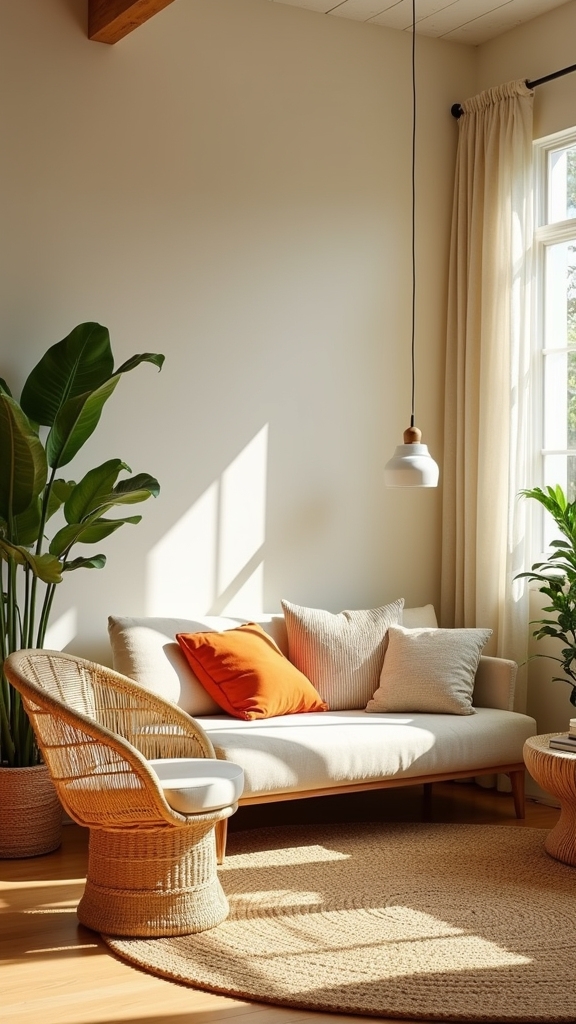
Texture plays a pivotal role in defining the ambiance of a beige living room, and rattan and woven furniture accents introduce essential warmth and depth to the space. These natural elements are renowned for their ability to enhance the Living area’s organic character while boosting both visual and tactile interest.
Rattan and woven accents infuse warmth and depth, transforming a beige living room with inviting texture and organic charm.
To optimize design and function, consider the following:
- Rattan accent chairs offer lightweight flexibility, allowing easy rearrangement for varying social scenarios.
- Woven baskets provide dual-purpose practicality—serving as both storage solutions and decorative features.
- Pairing rattan furniture with green accents, such as botanical elements or verdant pillows, intensifies a nature-inspired motif.
- Incorporating woven rugs or subtle woven decor further enriches the room’s textural layers, reinforcing a cohesive, earthy aesthetic.
A beige living room can also benefit from an earthy color palette featuring shades like terracotta and cream, adding serenity and fostering a connection to nature. This approach creates an inviting, adaptable Living environment.
Linen and Cotton Soft Furnishings
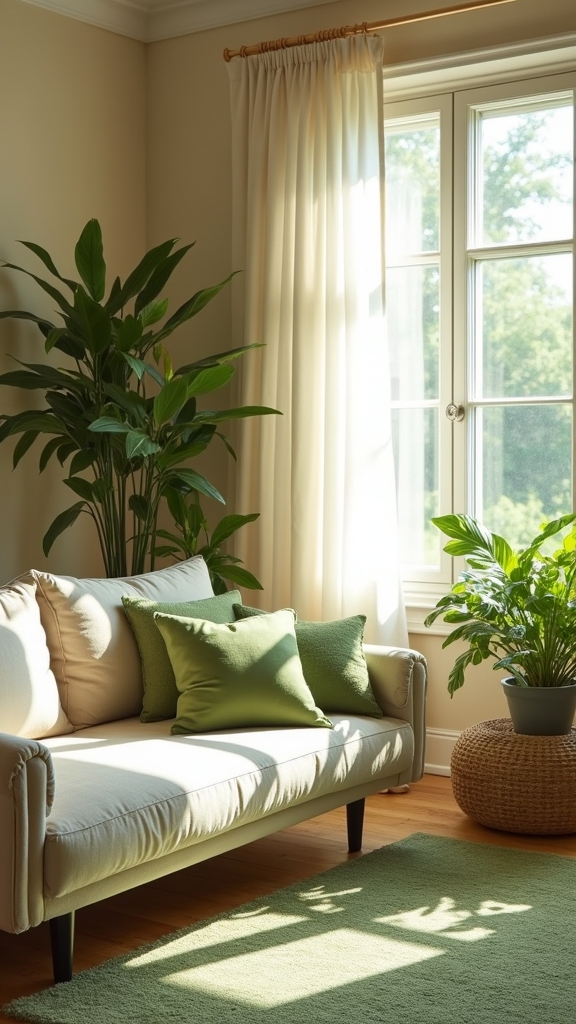
Introducing linen and cotton soft furnishings infuses a beige living room with a refined sense of calm, while strategically layering tactile interest. Expert Fabric Selection is critical—linen, with its breathable weave, provides an airy ambiance ideal for curtains, pillows, and throws. Its natural texture reinforces the nature-inspired scheme. Cotton, known for its softness and durability, complements linen by adding inviting comfort to cushions and other soft furnishings. Utilizing a blend of these textiles achieves depth through layered textures, imparting visual dynamism without disrupting tranquility. Opting for neutral tones such as cream or soft beige allows green accents to remain focal, enhancing the organic aesthetic. Both linen and cotton are practical and easy-care, underscoring the functional longevity central to a relaxed, nature-inspired living space. Incorporating earthy-toned velvet sofas can further enrich the room with depth and richness, complementing the natural theme.
Statement Green Artwork
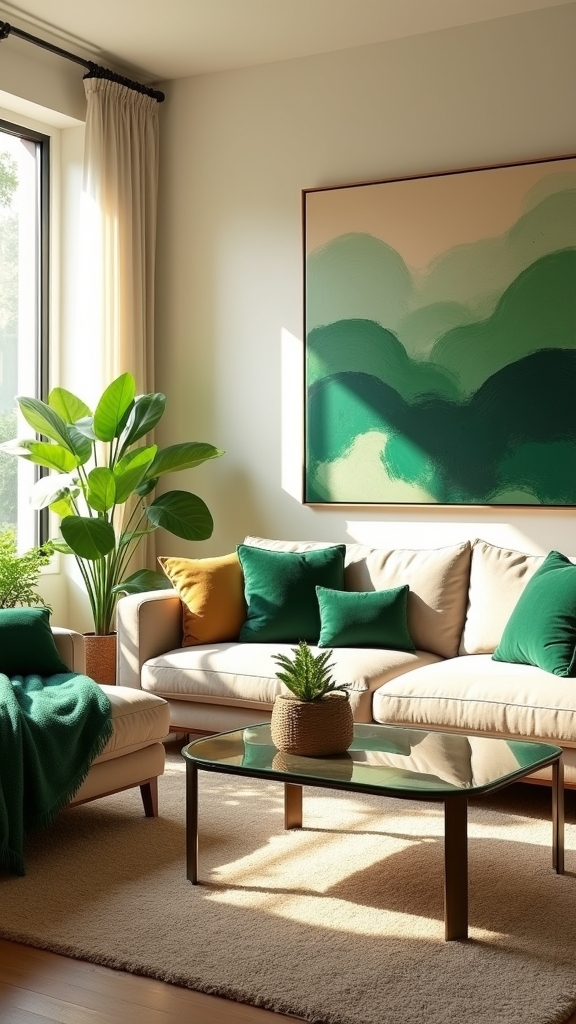
Balancing the tactile appeal of linen and cotton soft furnishings, the introduction of statement green artwork establishes a compelling focal point within the beige living room.
Expertly curated, these artistic pieces utilize a spectrum of green—from emerald to sage—leveraging Artistic Techniques such as layered brushwork and textured mediums to evoke depth and visual interest.
A spectrum of green hues and textured techniques brings dynamic depth and captivating visual interest to any neutral living space.
Strategic placement and scale are essential for maximizing impact. To optimize aesthetic integration, consider the following:
- Select large-scale abstract or botanical compositions for pronounced visual emphasis.
- Employ varying shades of green to harmonize with beige and enhance spatial tranquility.
- Position artwork at eye level against a neutral backdrop for heightened contrast and definition.
- Opt for framed pieces incorporating natural wood for cohesive, nature-inspired synergy.
Incorporating statement metal wall sculptures can further enhance the overall room ambiance, adding striking visual elements and timeless elegance to the space.
This approach guarantees functional elegance rooted in sophisticated design principles.
Wooden Elements for Organic Warmth

Introducing natural wood furniture choices infuses the beige living room with organic warmth, providing a visually grounding counterpoint to green accents.
Textured timber decor accents, such as carved trays or woven wood wall art, enrich the tactile environment and reinforce the room’s biophilic theme.
Both elements functionally enhance the space by balancing softness with structural integrity, fostering an inviting yet sophisticated atmosphere.
Incorporating layered lighting techniques helps to further enhance the cozy and inviting ambiance, creating a warm and comfortable environment.
Natural Wood Furniture Choices
Natural wood furniture—crafted from oak, maple, or walnut—infuses a beige living room with organic warmth and tactile depth, reinforcing the tranquil ambience established by green accents.
When selecting pieces, wood finish plays a pivotal role in shaping both the mood and visual cohesion of the space. Expert guidance highlights several strategic choices for ideal results:
- Light wood finishes (birch, pine) maximize brightness, complementing beige and green palettes.
- Darker species (mahogany, walnut) introduce contrast and richness, grounding the design.
- Mixed wood textures—smooth tabletops with rough-hewn legs—add dimensionality without overwhelming the calm aesthetic.
- Functional wooden elements such as reclaimed tables or rustic sideboards deliver both utility and nature-inspired authenticity.
Each choice enhances the space’s organic sophistication and tactile comfort.
Textured Timber Decor Accents
Timber accents—ranging from reclaimed wood furniture to decorative bowls—infuse a beige living room with organic warmth and tactile richness.
The strategic application of Timber Textures, such as light oak or deep walnut finishes, establishes visual depth and contrast against neutral walls.
Smooth, polished surfaces juxtaposed with rough-hewn timber elements, like handcrafted coffee tables or wooden wall art, provide dynamic focal points and enhance sensory appeal.
Incorporating a spectrum of wood finishes not only amplifies aesthetic cohesion but also underscores a biophilic design approach.
Wooden picture frames and accent shelves further integrate natural motifs, reinforcing a serene, inviting environment.
Layering diverse Timber Textures delivers dimensionality and enhances the living space, creating a tranquil retreat that resonates with nature-inspired sophistication and functional elegance.
Soft Lighting for a Serene Atmosphere
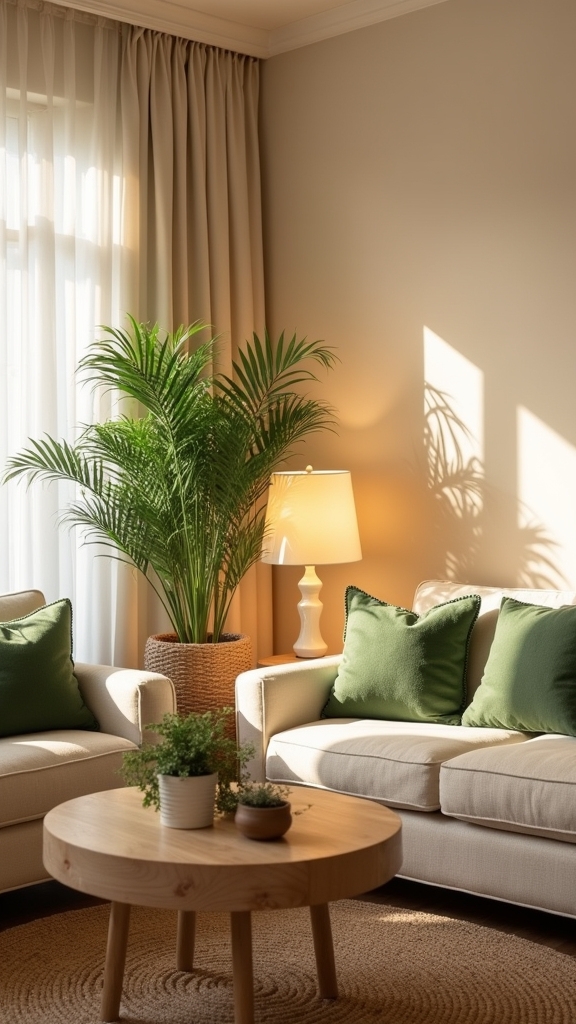
Ambient illumination serves as a cornerstone in crafting a serene atmosphere within a beige living room accented by green tones.
Expertly layered mood lighting solutions are essential for enhancing tranquility and visual cohesion. Soft lighting, such as recessed or dimmable fixtures, delivers a warm, enveloping glow that seamlessly complements the room’s natural palette.
The integration of functional and aesthetic lighting can be approached through the following strategies:
- Install recessed or dimmable fixtures to provide a customizable ambient backdrop.
- Utilize table and floor lamps with soft white bulbs for depth and relaxation.
- Incorporate sheer curtains to diffuse natural light, amplifying the room’s calmness.
- Position battery-operated accent lights near plants or decor to highlight organic textures and create a soothing evening radiance.
Additionally, energy-efficient lighting options like LED bulbs can be employed to reduce consumption and lower energy costs, aligning with sustainable design principles. These techniques perfect a rejuvenating living environment.
Built-In Shelving With Greenery
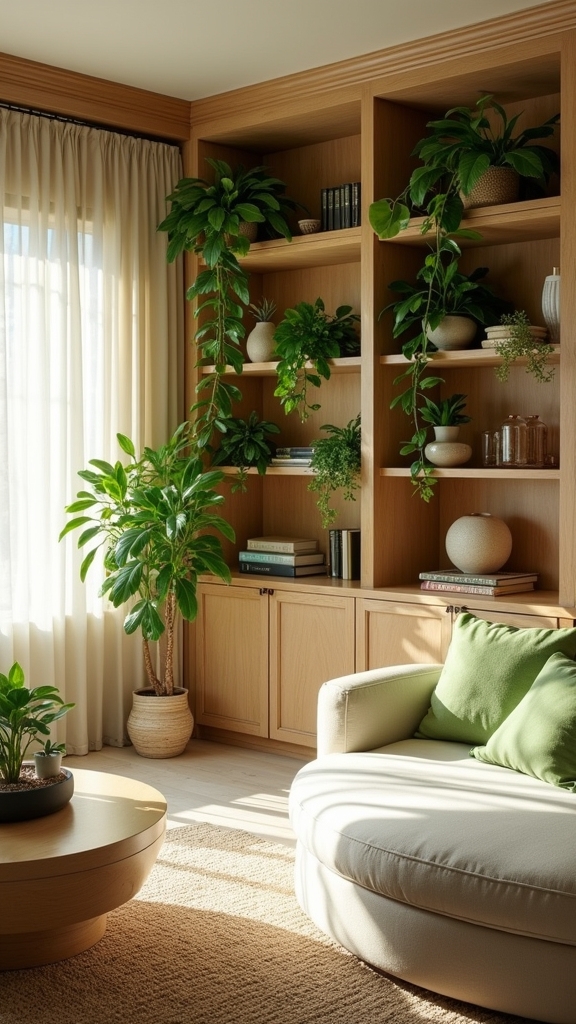
While layered lighting establishes a calming foundation, built-in shelving introduces both structure and organic energy to a beige living room with green accents.
Expertly designed shelves serve as architectural anchors, transforming Greener Spaces into visually compelling focal points. By selecting a curated mix of potted plants—ranging from trailing vines to sculptural succulents—a dynamic interplay of height and texture emerges, enhancing the natural ambiance.
Shelving paired with curated greenery creates striking focal points, introducing visual interest and a refreshing sense of natural vitality.
Employing cream or light-colored pots guarantees a seamless integration with the beige palette, directing attention to the vibrant foliage. Integrated shelf lighting accentuates the greenery, adding depth and warmth after sunset.
This functional approach not only raises design but also supports indoor air quality, reflecting a holistic commitment to wellness and aesthetic harmony in contemporary Greener Spaces.
Subtle Patterns in Green and Beige
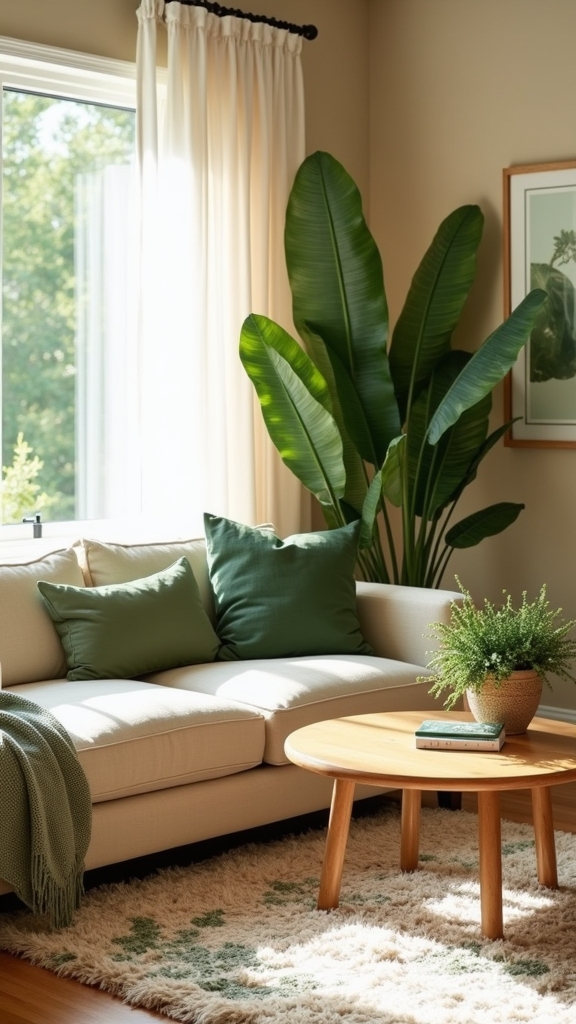
A restrained introduction of subtle patterns in green and beige establishes a sophisticated visual rhythm within a living room, amplifying its organic undertones.
This Pattern Play leverages nuanced geometrics and botanical motifs to enhance serenity while integrating tactile dimension. Selective use of these patterns guarantees the palette remains cohesive, offering functional beauty and depth without visual clutter.
To maximize the nature-inspired ambiance, designers rely on pattern layering and strategic placement, ensuring that each element contributes to a tranquil whole.
- Patterned Textiles: Cushions, area rugs, and drapery in soft green and beige introduce visual interest and tactile appeal.
- Delicate Wallpaper: Accent walls with understated green motifs create intentional focal points.
- Botanical Prints: Organic-inspired patterns reinforce the nature-driven design narrative.
- Geometric Accents: Subtle geometric forms add contemporary structure while maintaining harmony.
Mixing Modern and Classic Furniture
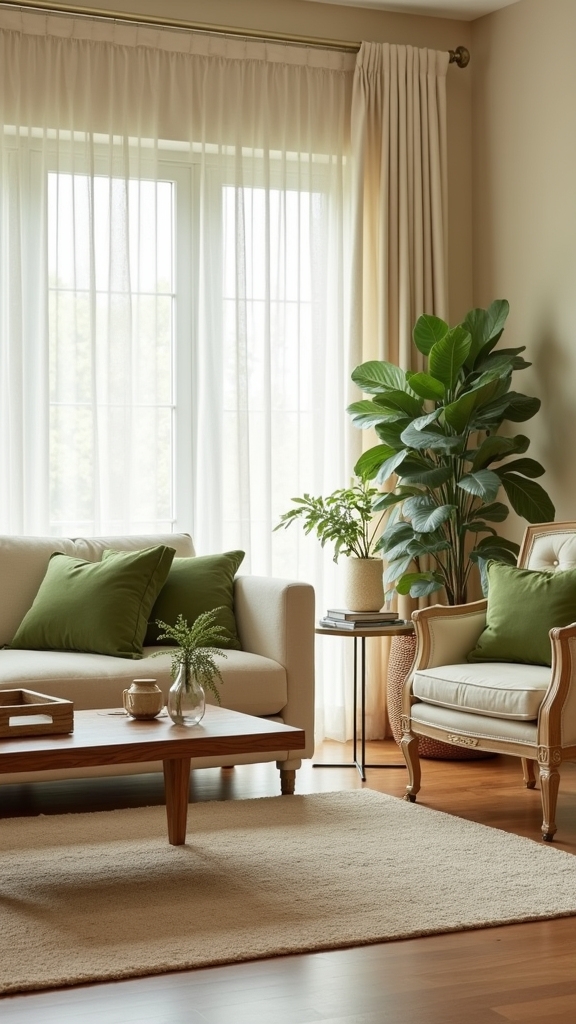
Combining modern and classic furniture within a beige living room punctuated by green accents introduces curated contrast and spatial balance.
Furniture Fusion in this scenario leverages the restrained warmth of beige walls to allow contemporary silhouettes and vintage profiles to coexist seamlessly. A sleek, modern coffee table juxtaposed with a vintage rattan chair exemplifies this interplay, providing both aesthetic intrigue and conversational value.
The integration of a contemporary sectional sofa with classic wooden side tables merges comfort with timeless elegance, while layered textures—smooth modern fabrics against woven traditional elements—add tactile richness.
Green accents, whether in textiles or artwork, stand out vibrantly against the neutral canvas, enhancing cohesion.
This deliberate Furniture Fusion optimizes both functionality and visual appeal, crafting a living room that is both inviting and refined.
Personal Touches With Green Accessories
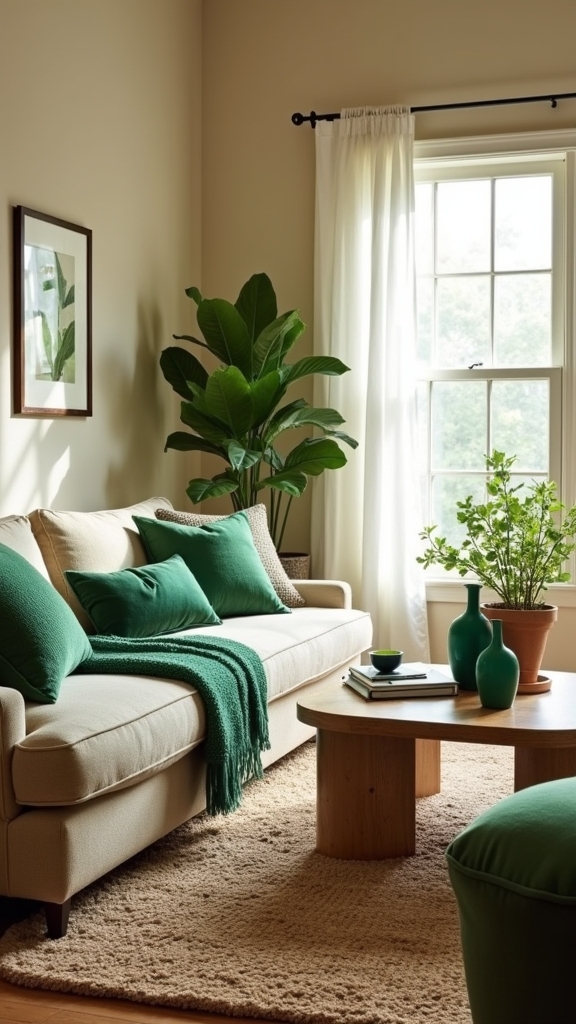
Strategic integration of green accessories transforms a beige living room by punctuating the neutral palette with dynamic visual interest and reinforcing a nature-inspired theme.
Expertly selected Green Textiles, such as cushions and throws in olive or sage, infuse the environment with layered depth and a cohesive chromatic narrative. Potted plants and botanical artwork function as organic focal points, amplifying a tranquil and invigorating ambiance.
Green textiles and botanical accents bring depth and vibrancy, transforming beige spaces into tranquil, nature-inspired retreats.
To further personalize the space while adhering to the nature motif, consider the following:
- Incorporate Green Textiles—throws, cushions, and poufs in varied green hues.
- Display verdant ceramics or vases as visual anchors.
- Integrate potted plants for both air purification and biophilic design.
- Utilize nature-inspired frames for personal photos or curated artwork.
Each element synergistically enhances the beige foundation with purposeful distinction.
Open, Airy Layouts for Tranquility
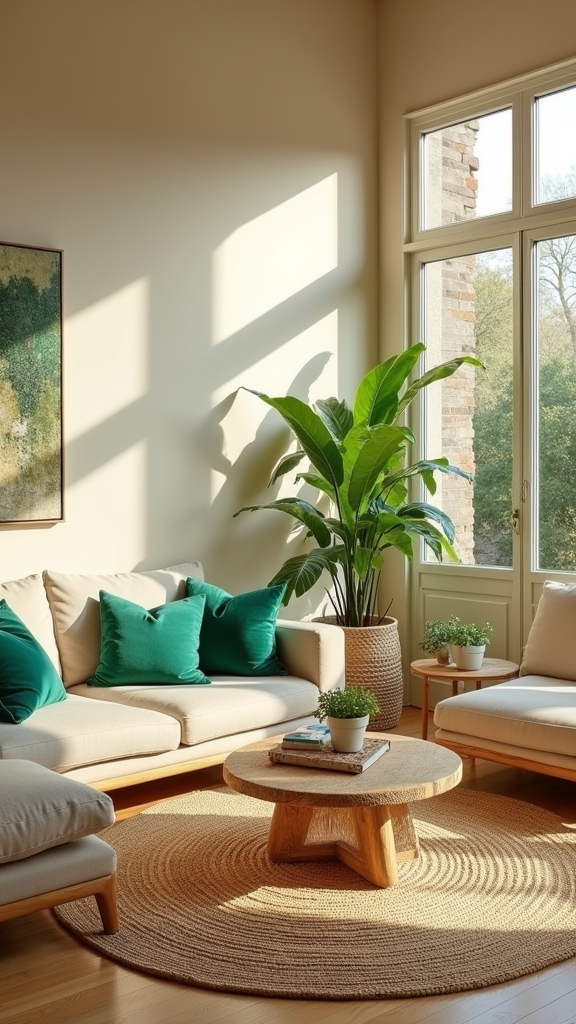
An open, airy layout leverages expansive glazing and unobstructed sightlines to optimize natural light, reinforcing the tranquil aesthetic of a beige living room.
Strategic furniture placement—favoring low-profile pieces—maintains spatial fluidity while supporting functional zones for relaxation and conversation.
Seamless shifts between interior and exterior environments further enhance serenity, emphasizing a harmonious connection with nature.
Maximizing Natural Light
While open layouts inherently promote the seamless flow of natural light, their effectiveness in a beige living room with green accents lies in intentional spatial planning.
To achieve maximum luminance and tranquility, natural ventilation and illumination are prioritized through curated design strategies:
- Position seating and décor away from windows to optimize sunlight penetration, amplifying both brightness and spatial perception.
- Select sheer window treatments, which diffuse daylight and safeguard privacy, all while sustaining the vibrancy of beige and green tones.
- Integrate mirrors on strategic walls to reflect light, visually enlarging the space and reinforcing the airy ambiance.
- Employ light-colored furniture and decorative elements to harmonize with beige walls and green accents, cultivating a cohesive and open environment.
These methods guarantee that natural light and ventilation remain paramount, harmonizing aesthetics and function.
Strategic Furniture Placement
Building on the advantages of abundant natural light, the spatial configuration of furniture becomes a primary determinant of tranquility in a beige living room with green accents.
Expertly executed furniture arrangement mandates positioning sofas and chairs to foster conversation, while ensuring open pathways that visually expand the space and maintain an inviting ambiance.
Central coffee tables serve as both functional anchors and focal points, promoting balance within the seating arrangement.
Side tables and accent chairs are employed to delineate intimate nooks, supporting individual relaxation and group interaction without overcrowding.
Built-in shelving or console tables against the perimeter optimize storage and display, preserving open floor area.
Lightweight, versatile pieces guarantee adaptability, allowing easy reconfiguration for various uses.
This strategic approach results in a harmonious, uncluttered environment.
Seamless Indoor-Outdoor Flow
Frequently, open and airy layouts serve as a conduit for seamless indoor-outdoor integration, utilizing spatial continuity to maximize tranquility in a beige living room with green accents.
Expertly executed indoor integration leverages architectural elements and thoughtful design choices to create a harmonious connection between interior and exterior environments.
Key strategies include:
- Expansive Glazing: Large windows and glass doors dissolve visual barriers, promoting natural light penetration and direct sightlines to outdoor greenery.
- Movable Partitions: Sliding or bi-fold doors enhance accessibility and establish an uninterrupted flow between spaces.
- Biophilic Elements: Incorporating potted plants and natural wood furniture further blurs the boundary, reinforcing the connection to nature.
- Unified Palette: A cohesive color scheme of beige with green accents aligns interior aesthetics with outdoor vistas, fostering a serene, integrated ambiance.
Frequently Asked Questions
What Color Goes With a Beige Living Room?
When considering color combinations for a beige living room, designers recommend incorporating earthy tones like olive, sage, or forest green. These hues enhance visual depth, establish a calming ambiance, and functionally complement beige’s versatile neutrality for cohesive interiors.
What Color Goes With Green for a Living Room?
When exploring Green Combinations for a living room, designers recommend pairing green with neutrals like cream or gray, introducing earthy terracotta, or using soft pinks and muted yellows to visually enhance depth, warmth, and natural ambiance.
How to Make a Beige Living Room Pop?
To make a beige living room pop, designers recommend integrating texture contrast through layered textiles, varied finishes, and accent elements. Adding tactile materials such as velvet, woven rugs, and metallic decor enhances visual interest and spatial dynamism.
Is a Green Living Room a Good Idea?
A green living room is a strategic choice, integrating biophilic design and sustainable decor. Green hues foster tranquility, enhance cognitive function, and visually connect interiors to nature, while plant-based elements improve air quality and functional aesthetics.
Conclusion
In conclusion, beige living rooms accented with green achieve a harmonious, nature-inspired ambiance through strategic color layering, tactile textiles, and botanical elements. Sage green walls and accessories introduce liveliness, while plush textures and layered neutral rugs enhance comfort. Subtle patterns and a blend of modern and classic furnishings add visual interest without overwhelming. Open layouts promote tranquility and functionality, making these spaces not only aesthetically refined but also highly livable and adaptable for both relaxation and gathering.
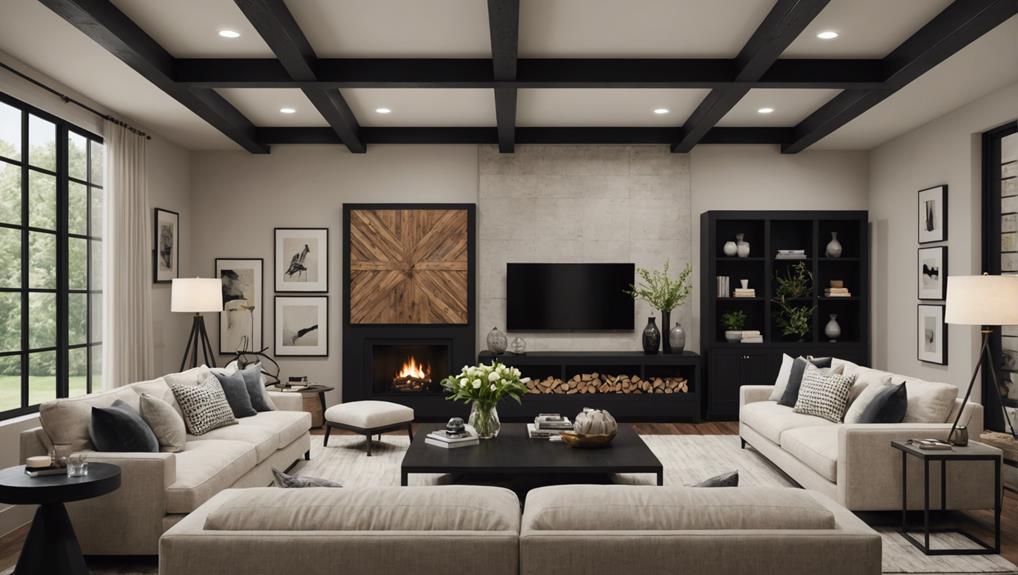
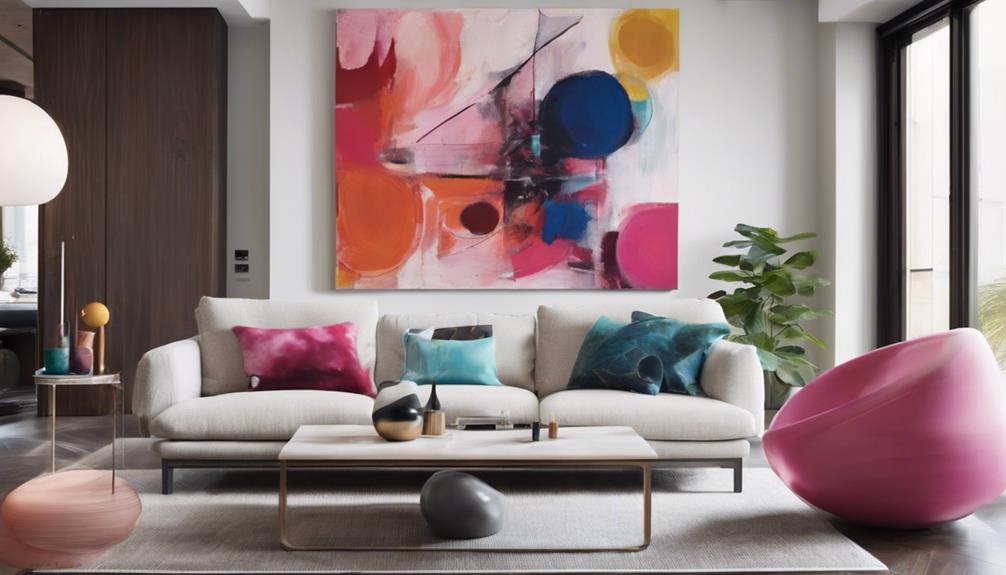
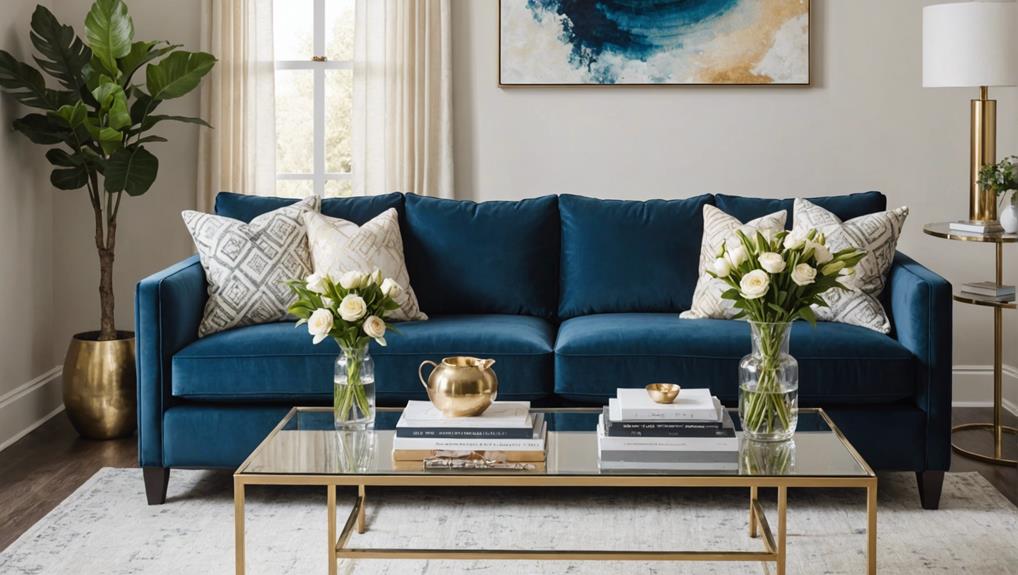
Leave a Reply